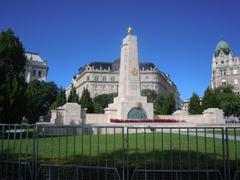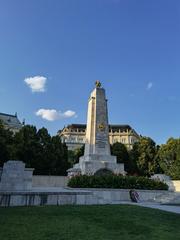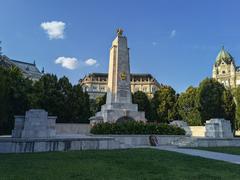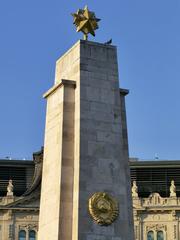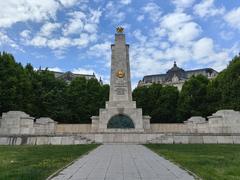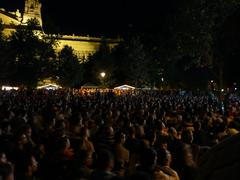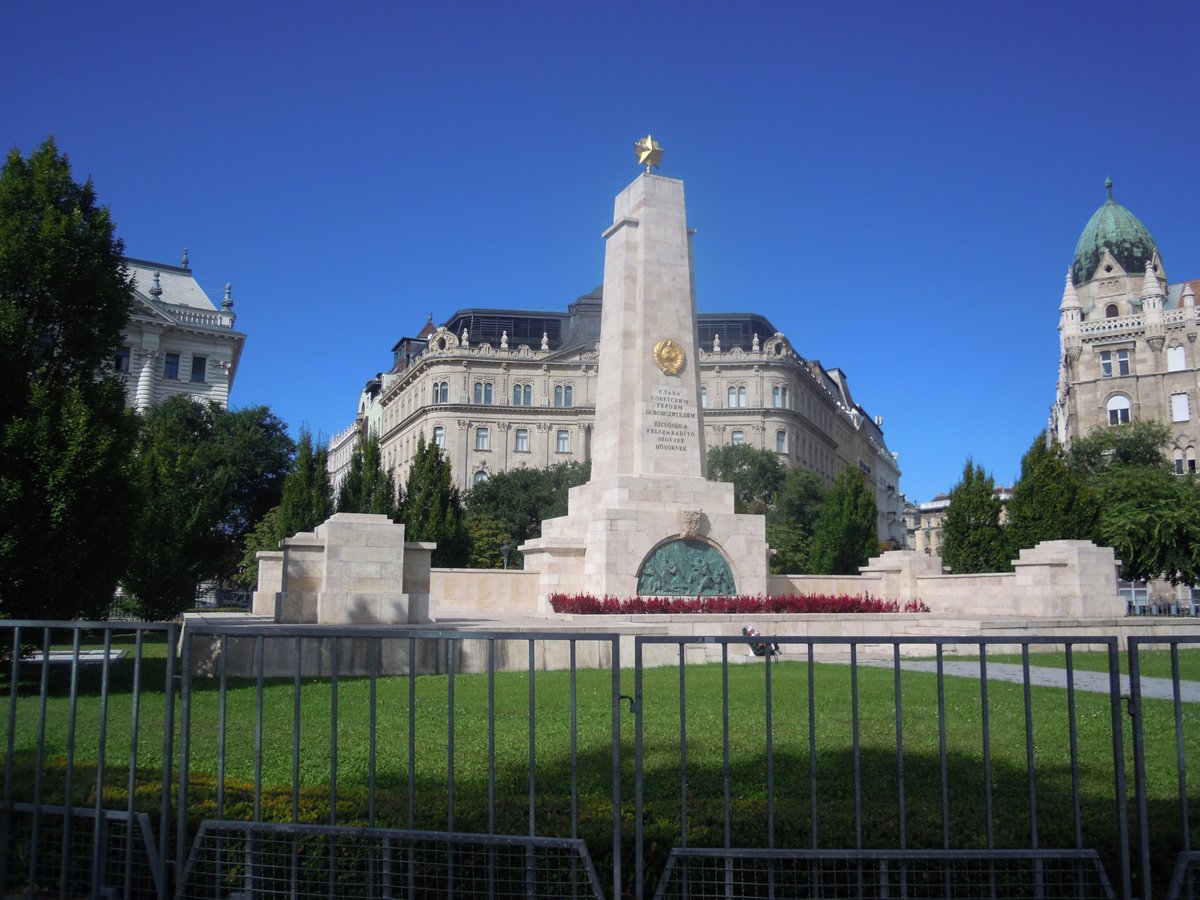
Szabadság Tér (Liberty Square) Budapest: Visiting Hours, Tickets, History, and Monument Guide
Date: 14/06/2025
Introduction to Szabadság Tér (Liberty Square) Budapest
Szabadság Tér, known in English as Liberty Square, is a defining landmark in the heart of Budapest’s Lipótváros district. Spanning approximately 200 by 150 meters, this grand urban plaza is steeped in Hungary’s turbulent history and is celebrated for its unique mix of architectural grandeur, thought-provoking monuments, and vibrant public life. Once the site of the infamous Újépület (New Building) barracks and prison—a symbol of Habsburg oppression—the area was transformed at the dawn of the 20th century into a public square reflecting the ideals of freedom and Hungarian sovereignty. Today, Szabadság Tér stands as a powerful testament to Hungary’s complex journey through revolution, occupation, and renewal (originalberlintours.com, mybuda.com).
Bordered by stunning examples of Beaux-Arts, Art Nouveau, and Secessionist architecture—such as the former Budapest Stock Exchange, the Hungarian National Bank, and the U.S. Embassy—the square is also home to some of Budapest’s most significant and controversial memorials, including the Soviet War Memorial, the Ronald Reagan statue, and the Memorial to the Victims of the German Occupation. As a freely accessible public space, Szabadság Tér invites visitors to explore Hungary’s layered history while enjoying its green lawns, fountains, and bustling civic events (en.wikipedia.org, Lonely Planet).
This comprehensive guide details Szabadság Tér’s historical evolution, architectural landmarks, key monuments, visiting hours, accessibility, travel tips, and nearby attractions—making it your essential resource for exploring one of Budapest’s most iconic spaces.
Historical Overview
Origins and Early History
The story of Szabadság Tér begins with the Újépület, a massive Habsburg military barracks and prison built in 1786. The site became infamous following the 1848–49 Hungarian Revolution, when Hungarian Prime Minister Lajos Batthyány and other revolutionaries were executed here, marking it as a place of both oppression and the struggle for national independence (originalberlintours.com, mybuda.com).
After the Austro-Hungarian Compromise of 1867, the Újépület became increasingly untenable as a symbol of foreign domination. Its demolition in 1897 was widely seen as a symbolic act of reclaiming Hungarian sovereignty. The newly cleared space was transformed into a public square and officially named Szabadság Tér (Liberty Square) in 1900, directly referencing the ideals of the Hungarian Revolution (etd.ceu.edu, hu.wikipedia.org).
Urban Development and Architecture
At the turn of the 20th century, Szabadság Tér was developed into a grand civic space, with broad promenades, green lawns, and a mix of impressive buildings. The square’s southern promenade, initiated by Count István Széchenyi, still features a plane tree planted in 1846 by his wife—a rare living relic from the era (hu.wikipedia.org).
The architectural ensemble around the square includes the monumental Exchange Palace (Tőzsdepalota, 1905), designed by Ignác Alpár, the Hungarian National Bank, and the Secessionist-style U.S. Embassy building. These structures illustrate the economic ambitions and cosmopolitan spirit of Budapest in the late 19th and early 20th centuries (mybuda.com, en.wikipedia.org).
Political and Symbolic Significance
Throughout the 20th century, Szabadság Tér has mirrored Hungary’s shifting political landscape:
- Interwar Period: The square was a focus for national mourning and irredentist sentiment after the Treaty of Trianon, with monuments commemorating lost territories (etd.ceu.edu).
- World War II and Soviet Era: Soviet forces erected a prominent war memorial in 1946 to commemorate the liberation of Budapest from Nazi occupation. The period also saw the erection and eventual destruction of a Stalin statue and the construction of the “Rákosi-bunker” beneath the square (hu.wikipedia.org).
- Post-Communist Era: New monuments, such as those honoring Ronald Reagan and George H.W. Bush, reflect Hungary’s democratic transition and Western alignment. The 2014 Memorial to the Victims of the German Occupation sparked significant debate over historical memory and Hungary’s role in WWII (en.wikipedia.org; etd.ceu.edu).
Key Monuments and Memorials
Soviet War Memorial
Located at the center of the square, this obelisk honors Soviet soldiers killed in WWII during the liberation of Budapest. It is Budapest’s last major Soviet-era memorial in a central public space, and its symbolism continues to provoke debate (Lonely Planet; Daily News Hungary).
Memorial to the Victims of the German Occupation
Unveiled in 2014, this monument depicts Hungary as the Archangel Gabriel attacked by a German imperial eagle. Critics argue it downplays Hungarian complicity in WWII atrocities. In response, a grassroots counter-memorial with photos, shoes, and personal tributes has grown in front of the monument (Academia.edu).
Ronald Reagan Statue
Erected in 2011, the statue of U.S. President Ronald Reagan honors his role in ending the Cold War and supporting Hungary’s transition to democracy. It stands facing the U.S. Embassy and the Parliament, symbolizing the country’s Western ties (ibnbattutatravel.com).
Harry Hill Bandholtz Statue
This monument celebrates the American general who protected the Hungarian National Museum during the 1919 Romanian occupation. Removed during the communist era, it was restored in 1989 as a symbol of American-Hungarian friendship (en.wikipedia.org).
Exchange Palace (Tőzsdepalota)
This Beaux-Arts masterpiece, completed in 1905, once hosted the Budapest Stock Exchange and later the Hungarian State Television. Currently under renovation, it remains a key architectural landmark (Daily News Hungary).
Fountain and Playgrounds
Interactive fountains at the square’s entrance offer a playful attraction, especially for children, and several playgrounds and green lawns provide a relaxing setting for families and locals (Hungary Budapest Guide).
Additional Architectural Highlights
- Hungarian National Bank: Features ornate reliefs and Art Nouveau design (Lonely Planet).
- Royal Postal Savings Bank: Ödön Lechner’s Secessionist masterpiece with vibrant folk motifs.
- U.S. Embassy: A historic Secessionist building central to diplomatic life in Budapest.
Practical Visitor Information
Visiting Hours and Entry
- Szabadság Tér is open 24/7 year-round as a public space.
- No ticket or entry fee is required to visit the square or its outdoor monuments.
Accessibility
- Wheelchair-accessible with paved paths and ramps.
- Benches, playgrounds, and green spaces make it family-friendly.
Getting There
- Metro: Line M2 (Kossuth Lajos tér station); also close to M3 and M1.
- Tram: Lines 2, 47, and several bus lines stop nearby.
- Parking: Underground parking is available beneath the square for visitors arriving by car (Hungary Budapest Guide).
Guided Tours
- Numerous walking tours include Szabadság Tér, offering expert insights into the square’s history and monuments. Guided and app-based self-guided tours are available (Budapestinfo.hu, Szabadság Tér Virtual Tour).
Best Time to Visit and Photo Tips
- Spring and autumn provide mild weather and fewer crowds.
- Golden hour (early morning or late afternoon) offers optimal lighting for photography of the monuments and architecture.
Nearby Attractions
- Hungarian Parliament Building (5-minute walk)
- St. Stephen’s Basilica (10-minute walk)
- Danube Promenade, Chain Bridge, and Andrássy Avenue are also close by.
Facilities
- Public restrooms, interactive fountains, and a café are available on-site.
Civic Life and Cultural Events
Szabadság Tér is not only a site of historic commemoration but also a lively venue for open-air exhibitions, public ceremonies, and seasonal festivals. National holiday celebrations, music events, and art installations regularly activate the square, making it a dynamic part of Budapest’s urban life (Budapest.city, Just Budapest).
Memory Politics and Ongoing Debates
The co-existence of Soviet, American, and national monuments on Szabadság Tér highlights Hungary’s ongoing struggle with its 20th-century legacy. The square has become a focal point for debates about history, identity, and public memory—a living space where past and present meet, and where local activism has made visible the complexity of Hungary’s historical narratives (Academia.edu).
Frequently Asked Questions (FAQ)
Q: What are the opening hours of Szabadság Tér?
A: The square is open 24/7.
Q: Is there an entrance fee?
A: No, the square and its monuments are free to access.
Q: Are guided tours available?
A: Yes, many walking tours include Szabadság Tér, and self-guided options are also available.
Q: Is Szabadság Tér accessible for wheelchairs and families?
A: Yes, there are paved paths, playgrounds, and accessible facilities.
Q: What is the best time to visit for photography?
A: Early morning or late afternoon for optimal lighting and fewer crowds.
Summary and Visiting Tips
Szabadság Tér (Liberty Square) offers a rich tapestry of Budapest’s past and present—combining grand architecture, poignant memorials, and lively civic spaces. Its central location, free entry, and accessibility make it a perfect destination for history enthusiasts, families, or anyone seeking to experience Budapest’s layered heritage. Enhance your visit with guided tours, take time to reflect at the memorials, and enjoy the vibrant atmosphere that makes Szabadság Tér a living symbol of the city’s enduring spirit.
For more in-depth guides, download the Audiala app for interactive tours and up-to-date information, and follow us on social media for the latest tips and events.
Sources and Further Information
- The History and Stories of Budapest’s Liberty Square – Original Berlin Tours
- What Stands in Liberty Square? Statues, Stories and Historic Buildings of Budapest – MyBuda
- Kalotay Marton, 2017, Central European University
- Szabadság tér (Budapest) – Hungarian Wikipedia
- Liberty Square (Budapest) – Wikipedia
- Freedom Square, Budapest – A View On Cities
- 25 Can’t-Miss Statues and Memorials in Budapest – Ibn Battuta Travel
- Memorial and Counter-Monument in Liberty Square Budapest – Academia.edu
- Everything You Need to Know About the Soviet Monument on Budapest’s Freedom Square – Daily News Hungary
- Budapest Official Tourism Website – Budapestinfo.hu
- Szabadság Tér Virtual Tour
- Liberty Square, Budapest – Hungary Budapest Guide
- Budapest City Attractions – Liberty Square
